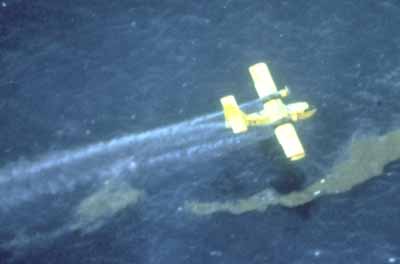|
Dispersants: A Guided Tour - Part Three
How Do Dispersants Work?
Dispersants work much like the detergent soap that you use to clean grease from your dishes (but dispersants are less toxic). They contain molecules with a water-compatible ("hydrophilic") end and an oil-compatible ("lipophilic") end. These molecules attach to the oil, reducing the interfacial tension between oil and water, breaking up the oil slick, as shown below.
How Are Dispersants Applied?
Dispersants are usually applied by airplane or helicopter, but also can be applied by boat. To increase the chances that an application will be effective, spill responders try to choose the best combination of dispersant droplet size, concentration, and rate of application. They also try to carefully target dispersant applications, sometimes even using spotter planes that use infrared detectors to locate spilled oil as precisely as possible.
(You can see more photos of dispersant applications in our Dispersant Application Observer's Guide.)
 |
|
Here, an airplane applies dispersant to a streamer of oil.
|
|


